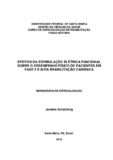| dc.contributor.advisor | Silva, Antônio Marcos Vargas da | |
| dc.creator | Schardong, Jociane | |
| dc.date.accessioned | 2019-06-04T15:30:56Z | |
| dc.date.available | 2019-06-04T15:30:56Z | |
| dc.date.issued | 2012-07-05 | |
| dc.date.submitted | 2012 | |
| dc.identifier.uri | http://repositorio.ufsm.br/handle/1/16739 | |
| dc.description | Monografia (especialização) - Universidade Federal de Santa Maria, Centro de Ciências da Saúde, Curso de Especialização em Reabilitação Físico-Motora, RS, 2012. | por |
| dc.description.abstract | This paper aims at evaluating the effects of functional electrical stimulation (FES)
on the strength, resistance and muscular trofism in lower limbs, cardio respiratory fitness
and quality of life in patients who are in stage II and II of the cardiac rehabilitation (CR).
It is about a randomized clinic trial, having 20 individuals who were previously submitted
to Bypass Graft Surgery and/or Aortic Valve Replacement and changed randomly to the
placebo group (PG=10) or treatment group (FESG=10). The evaluations carried out
before and after the intervention were the following: Test of One Maximum Repetition for
muscular strength, Sitting and Standing Test for resistance; perimeter of the thighs for
muscular trofism; Six-minute Walking Test for cardio respiratory capability; and
application of questionnaire SF-36 in order to evaluate the quality of life. The patients
were submitted to the application of FES in their quadriceps for eight weeks, twice a
week, for 40min each session. The PG received the FES in a way that the electrical
current caused only a tingling sensation, on the other hand, the FESG received the FES
in a way so it caused visible muscle contraction, therefore the knees could extend and
the increase of overload up to 30% in the 1MR. Concerning the findings in the study,
FES increased significantly the strength and the muscular resistance in both groups,
however in a higher level in FESG. There were a few increases in the SF-36 dominance
with the use of FES. In view of that, it is possible to conclude that FES is a valuable tool
and it may contribute to improve the muscular performance in lower limbs of CR patients. | eng |
| dc.language | por | por |
| dc.publisher | Universidade Federal de Santa Maria | por |
| dc.rights | Acesso Aberto | por |
| dc.rights | Attribution-NonCommercial-NoDerivatives 4.0 International | * |
| dc.rights.uri | http://creativecommons.org/licenses/by-nc-nd/4.0/ | * |
| dc.subject | Estimulação elétrica funcional | por |
| dc.subject | Reabilitação | por |
| dc.subject | Desempenho físico | por |
| dc.subject | Qualidade de vida | por |
| dc.subject | Functional electrical stimulation | eng |
| dc.subject | Rehabilitation | eng |
| dc.subject | Physical performance | eng |
| dc.subject | Quality of life | eng |
| dc.title | Efeitos da estimulação elétrica funcional sobre o desempenho físico de pacientes em fase II e III da reabilitação cardíaca | por |
| dc.title.alternative | Functional electrical stimulation effects on physical performance of patients in phase II and III of cardiac rehabilitation | eng |
| dc.type | Trabalho de Conclusão de Curso de Especialização | por |
| dc.degree.local | Santa Maria, RS, Brasil | por |
| dc.degree.specialization | Reabilitação Físico-Motora | por |
| dc.description.resumo | Este trabalho teve como objetivo avaliar os efeitos da estimulação elétrica
funcional (FES) sobre a força, resistência e trofismo muscular de membros inferiores,
aptidão cardiorrespiratória e qualidade de vida de pacientes em fase II e III da
reabilitação cardíaca (RC). Trata-se de um ensaio clínico randomizado, contando com
20 sujeitos submetidos anteriormente à Cirurgia de Revascularização do Miocárdio
e/ou Troca Valvar e alocados aleatoriamente para o grupo placebo (GP=10) ou grupo
tratamento (GFES=10). As avaliações realizadas antes e após a intervenção foram as
seguintes: Teste de Uma Repetição Máxima para força muscular; Teste de Sentar e
Levantar para resistência; perimetria das coxas para trofismo muscular; Teste de
Caminhada de Seis Minutos para aptidão cardiorrespiratória; e aplicação do
questionário SF-36 para avaliar qualidade de vida. Os pacientes foram submetidos à
aplicação da FES no quadríceps durante oito semanas, duas vezes/semana, com
duração de 40 min/sessão. O GP recebeu a FES de forma que a corrente elétrica
provocasse apenas a sensação de formigamento, já o GFES recebeu a FES de forma
que esta provocasse contração muscular visível, podendo ocorrer a extensão dos
joelhos e o acréscimo de sobrecarga de até 30% do teste de 1RM. Em relação aos
achados do estudo, a FES aumentou de forma significativa a força e a resistência
muscular em ambos os grupos, porém com maior incremento para o GFES. Houve
poucos acréscimos nos domínios do SF-36 com a utilização da FES. Diante disso,
conclui-se que a FES trata-se de um recurso valioso e pode contribuir para melhorar a
performance muscular de membros inferiores de pacientes em RC. | por |
| dc.publisher.country | Brasil | por |
| dc.publisher.initials | UFSM | por |
| dc.subject.cnpq | CNPQ::CIENCIAS DA SAUDE | por |
| dc.publisher.unidade | Centro de Ciências da Saúde | por |



